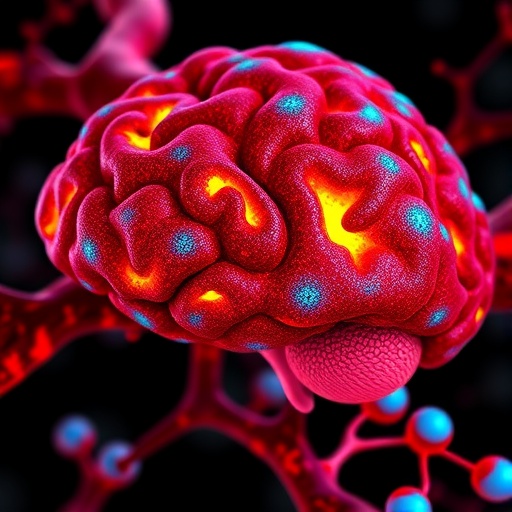In the rapidly evolving realm of cancer research, gliomas harboring mutations in isocitrate dehydrogenase (IDH) have long puzzled scientists and clinicians alike due to their heterogeneous clinical outcomes. While IDH-mutant gliomas generally present a more favorable prognosis compared to their wildtype counterparts, patient survival rates remain widely variable, prompting a deeper exploration into the underpinnings of this unpredictability. A groundbreaking study recently published in BMC Cancer delineates a new framework for understanding this variability by unveiling distinct metabolic subtypes within IDH-mutant gliomas, shedding light on their prognostic implications and opening fresh avenues for targeted therapies.
Historically, glioma classification has heavily focused on genetic mutations and histopathological grades, often glossing over the metabolic intricacies that may subtly modulate tumor behavior. Recognizing this gap, a multinational team spearheaded by Wang and colleagues harnessed extensive transcriptomic data from an aggregate of public datasets alongside a unique patient cohort from Beijing Tiantan Hospital. By integrating data from thousands of IDH-mutant glioma cases, the researchers performed consensus clustering to categorize tumors based on their metabolic gene expression profiles, thus unraveling the metabolic heterogeneity obscured by conventional classifications.
The analysis culminated in the identification of three discrete metabolic subtypes, each distinguished by unique pathways and metabolic signatures. The first subtype is characterized by heightened carbohydrate and nucleotide metabolism, suggesting aggressive proliferation capacities fueled by increased energy and nucleic acid synthesis. The second subtype features an upregulation of amino acid and lipid metabolic pathways, indicative of altered bioenergetics and membrane remodeling processes. The third subtype reveals a complex metabolic reprogramming with elevated lipid, nucleotide, and vitamin metabolism, which may reflect adaptive mechanisms to oxidative stress and nutrient deprivation within the tumor microenvironment.
Significantly, these metabolic portraits were not restricted to transcriptomic inference alone. The independent metabolomics analysis of tumor samples from the Beijing Tiantan cohort validated the described metabolic phenotypes, reinforcing the robustness of this novel classification system. Such validation is crucial as it bridges the gap between gene expression and actual metabolic activity, a step often overlooked in prior studies.
The prognostic ramifications of this metabolic stratification are profound. Survival analyses revealed statistically significant differences among the three subtypes, with each metabolic profile correlating with distinct clinical outcomes. This suggests that metabolic phenotyping could serve as a powerful prognostic tool, enabling clinicians to better predict disease trajectory and tailor treatment regimens accordingly.
Delving deeper into the tumor-immune nexus, the study explored the relationship between metabolic subtypes and the immune microenvironment. Utilizing sophisticated computational tools such as CIBERSORTx and ESTIMATE to deconvolute immune cell infiltration patterns, researchers uncovered subtype-dependent immune landscapes. The interplay between altered metabolism and immune cell composition underscores a potential feedback mechanism where metabolic rewiring influences immune evasion and tumor progression.
One of the study’s noteworthy achievements lies in the derivation of a 13-gene metabolic signature capable of stratifying patients based on prognostic risk. This gene panel encapsulates crucial enzymes and transporters involved in distinct metabolic circuits, offering a tangible biomarker set for clinical application. More so, this signature provides a molecular handle on which to base therapeutic decision-making, potentially guiding personalized interventions.
To extend the clinical utility of their findings, Wang and colleagues probed drug sensitivities associated with each metabolic subtype using the CGP2014 drug library. This in silico screening illuminated subtype-specific vulnerabilities, suggesting that certain drugs could target metabolic dependencies unique to each subtype. Such targeted pharmacotherapy holds promise to revolutionize glioma treatment paradigms, moving away from one-size-fits-all strategies towards precision oncology.
Importantly, the study underscores the necessity of interpreting IDH-mutant gliomas through a metabolic lens, challenging the traditional dichotomy of IDH-mutant versus wildtype as the sole prognostic indicator. The metabolic subtyping not only enriches our biological comprehension of gliomas but also refines risk stratification frameworks, enhancing the precision of future clinical management.
From a mechanistic perspective, the elevated carbohydrate and nucleotide metabolism observed in the first subtype aligns with the Warburg effect, a hallmark of cancer metabolic reprogramming that supports rapid cellular growth. Conversely, the amino acid and lipid metabolic upregulation in the second subtype hints at alternative survival strategies, such as lipid droplet formation and amino acid catabolism, to thrive under harsh microenvironmental conditions.
The third subtype’s increased vitamin metabolism adds another layer of complexity, potentially reflecting augmented cofactor requirements for enzymatic reactions essential to sustaining malignant phenotypes. Such intricacies could unveil novel metabolic checkpoints that serve as therapeutic choke points.
The implications of the immune landscape findings are equally compelling. Metabolic alterations within tumor cells can modulate immune cell recruitment, activation, and function. The study’s evidence of subtype-specific immune infiltration patterns suggests that metabolic reprogramming might contribute to creating an immunosuppressive milieu, which could be exploited for combinatorial strategies integrating metabolic inhibitors with immunotherapies.
Crucially, this comprehensive study exemplifies how integrating multi-omics data with clinical information can yield transformative insights. The employment of LASSO regression to distill significant metabolic genes, alongside enrichment analyses and functional validations, embodies the gold standard in omics-driven biomarker discovery. This integrative approach paves the way towards actionable insights in the battle against gliomas.
In conclusion, the research conducted by Wang et al. represents a pivotal advancement in the understanding of IDH-mutant gliomas. By illuminating the metabolic diversity within these tumors, identifying correlating immune microenvironment alterations, and proposing potential therapeutic targets, the study charts a promising path forward for improving patient outcomes. Future clinical trials harnessing these metabolic subtyping strategies could herald a new era of precision medicine in neuro-oncology.
Subject of Research: Metabolic heterogeneity in IDH-mutant gliomas and its implications for prognosis and therapy.
Article Title: Novel metabolic subtypes in IDH-mutant gliomas: implications for prognosis and therapy
Article References:
Wang, P., Wang, J., Fang, Z. et al. Novel metabolic subtypes in IDH-mutant gliomas: implications for prognosis and therapy. BMC Cancer 25, 815 (2025). https://doi.org/10.1186/s12885-025-14176-y
Image Credits: Scienmag.com
DOI: https://doi.org/10.1186/s12885-025-14176-y
Tags: cancer research advancementsconsensus clustering in cancerglioma classification challengesglioma treatment implicationsIDH-mutant glioma prognosisisocitrate dehydrogenase mutationsmetabolic heterogeneity in tumorsmetabolic subtypes in gliomasnovel therapeutic strategies for gliomaspatient survival variabilitytargeted therapies for gliomatranscriptomic data analysis





